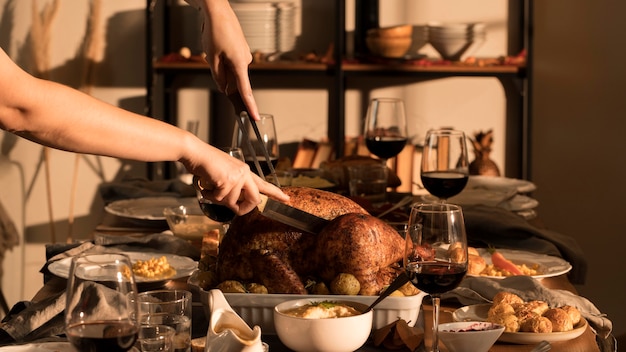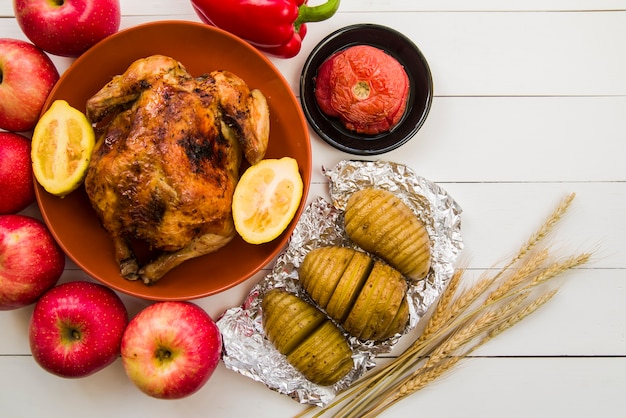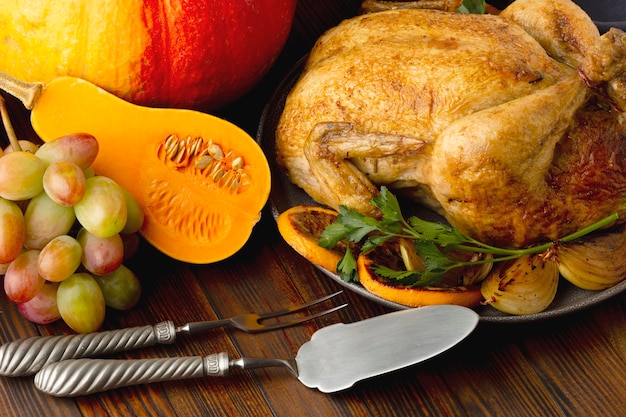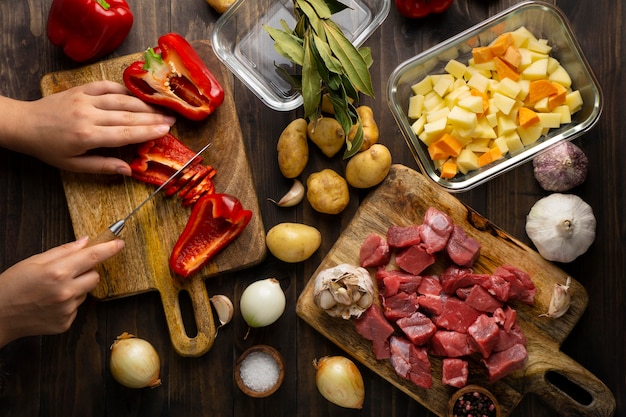A roast turkey – the centerpiece of countless festive gatherings, a symbol of tradition and a delicious culinary achievement. I've been tackling turkeys for years, and I've learned that a perfect turkey isn't just about getting the bird in the oven; it's about a series of steps, each contributing to a truly memorable experience. So, whether you're a seasoned pro or a first-timer, I'm here to guide you through every step, from selecting the right bird to achieving that beautiful golden brown skin. Let's embark on this delicious journey together!
Part 1: Choosing Your Turkey

1.1 Size Matters: A Bird for Every Feast
First things first, you need to determine the right size turkey for your gathering. It's a classic dilemma, isn't it? Too big, and you'll be swimming in leftovers for days. Too small, and you'll be wishing you'd gone for a larger bird. Here's the general rule of thumb: calculate about 1.5 pounds of turkey per person. For a family of four, that means a 6lb bird. If you're expecting a crowd, scale up accordingly. The last thing you want is to be caught short, especially when everyone's looking forward to the feast!
1.2 Fresh or Frozen: The Pros and Cons
Now, you've got a choice to make: fresh or frozen? Fresh turkeys are excellent if you have the time and know you'll be able to cook it within a few days of buying it. They tend to have a more delicate flavour. However, if you're working with a tighter schedule, frozen turkeys are a lifesaver. Just make sure you give them plenty of time to defrost properly before cooking. I've learned the hard way – there's nothing worse than realizing your turkey needs another day to thaw when everyone's ready to eat!
1.3 Selecting the Perfect Bird: A Guide for the Eyes
When choosing your turkey, give it a thorough inspection. It should have a plump breast, firm legs, and a clean, moist skin. If you're buying fresh, make sure it doesn't have any strange smells or discoloration. The more plump the bird, the more meat you'll have, which is always a bonus! It's all about finding a good, healthy-looking bird.
Part 2: Prepping Your Turkey for Perfection

2.1 The Brining Debate: Juiciness on the Line
Now, we're entering the realm of brining, a bit of a controversial topic in the world of turkey cooking. Some swear by it, others say it's unnecessary. I'm in the "brining is brilliant" camp. Brining, essentially soaking the turkey in a salty solution for a few hours, draws moisture into the meat, resulting in a turkey that's practically melting in your mouth. It's a game-changer for juiciness and tenderness.
2.2 The Art of Stuffing: A Flavour Symphony
Now, onto the stuffing, a real opportunity to let your culinary creativity shine. There's no right or wrong way to make it, but a few key elements contribute to a truly delicious stuffing. First, use a good, well-seasoned bread. Second, add a medley of tasty ingredients. I love using onions, celery, herbs, and nuts. And finally, ensure your stuffing is cooked through. You can cook it separately in a baking dish, or stuff the turkey directly. I prefer to cook it separately, as it ensures even cooking and prevents any potential issues with the turkey's internal temperature.
2.3 Readying Your Turkey for the Oven: The Final Touch
With your turkey prepped and your stuffing ready, it's time to prepare the bird for the oven. Pat it dry inside and out, then rub it with butter or olive oil. This helps the skin crisp up beautifully in the oven. Season it generously with salt, pepper, and any other herbs or spices you fancy. Remember, the flavour is in your hands!
Part 3: Cooking Your Turkey to Perfection

3.1 Temperature Time: The Importance of Safety
The moment has arrived. It's time to put your turkey in the oven. The most crucial aspect of turkey cooking is ensuring it reaches a safe internal temperature. This is where a meat thermometer becomes your trusted companion. Aim for an internal temperature of 165°F in the thickest part of the thigh. If you're stuffing the turkey, ensure the stuffing reaches 165°F as well. This is non-negotiable for food safety.
3.2 Cooking Time: A Guide for Every Bird
Now, let's talk about cooking time. This is where things can get a bit tricky, as the time varies depending on the turkey's size. As a general rule, it takes about 15 minutes per pound at 325°F. But always double-check with a meat thermometer to ensure the turkey is thoroughly cooked.
3.3 Rest Time: A Crucial Step for Juiciness
Don't be tempted to carve your turkey straight out of the oven. It needs time to rest, allowing the juices to redistribute throughout the meat. Let it sit for about 30 minutes before carving. This simple step makes a world of difference in terms of juiciness and flavour.
Part 4: Carving Your Turkey: A Culinary Skill4.1 The Carving Chronicles: A Step-by-Step Guide
Once your turkey has rested, you can finally carve it up. Grab a sharp carving knife and a cutting board. I like to start by cutting the legs off. Then, I separate the thighs from the drumsticks. Next, I remove the breast and slice it into thin pieces. Finally, I carve the wings from the bird. And voila, you have a beautifully carved turkey, ready to be enjoyed.
Part 5: Serving Up Your Feast: A Moment of Celebration
5.1 Presentation Perfection: A Culinary Art
With your turkey carved, it's time to present it beautifully. I like to arrange the slices of turkey on a platter, with the drumsticks, thighs, and wings around the edges. Then, I add some gravy, stuffing, and all the trimmings. It's a culinary art form, a feast for the eyes before it becomes a feast for the taste buds!
5.2 Feasting with Friends and Family: The Heart of the Occasion
And there you have it, your delicious roast turkey, ready to be devoured. Gather your loved ones, create a warm and inviting atmosphere, and enjoy the fruits of your labour. It's the perfect way to celebrate any occasion, creating memories that will last a lifetime.
Part 6: Stuffing Delights: A Deeper Dive
6.1 The Art of Stuffing: A Symphony of Flavours
We've touched on stuffing briefly, but it deserves a more in-depth exploration. Stuffing is a flavour bomb, adding so much depth to the turkey experience. There are endless variations, but the basic idea is to combine bread, herbs, vegetables, and sometimes meat or sausage. The key is to ensure it's well-seasoned and cooked through.
6.2 Stuffing Styles: A Culinary Playground
I'm a big fan of classic sausage stuffing, but you can be incredibly creative with your fillings. You can use dried fruits, nuts, or even cranberries. There are even vegetarian stuffing options, like wild rice stuffing or quinoa stuffing. The possibilities are endless, allowing you to tailor the stuffing to your preferences and the occasion.
6.3 Cooking Your Stuffing: Ensuring Perfection
As I mentioned earlier, I prefer to cook my stuffing separately from the turkey. This ensures that it's cooked through and doesn't dry out in the oven. I bake it in a casserole dish until it's golden brown and bubbly, achieving that perfect texture and flavour.
Part 7: Beyond the Basic Turkey: Exploring Alternatives
7.1 Turkey Alternatives: Expanding Your Options
Let's face it, turkey isn't for everyone. If you're not a fan of turkey, there are plenty of other options for your holiday feast. You could go for a roast goose, duck, or even a ham. There's also the option of a vegetarian roast, like a nut roast or a lentil loaf. The world of culinary delights is vast, so don't be afraid to explore different options.
7.2 Spicing Things Up: Adding a Touch of Adventure
If you're looking to add some excitement to your turkey, try rubbing it with a spice blend. You could use a classic blend of thyme, rosemary, and sage, or go for something more adventurous like a Cajun spice rub or a Moroccan spice blend. A touch of spice can elevate your turkey to new heights of flavour.
7.3 Turkey Twists: A culinary adventure
You can also get creative with your turkey by trying different cooking methods. You could try roasting your turkey in a beer brine, or even smoking it on a barbecue. Experimenting with different techniques allows you to personalize your turkey and explore new culinary horizons.
Part 8: Leftover Turkey Wonders: A Culinary Treasure Trove
8.1 From Feast to Feast: The Art of Leftover Creativity
The best part about a roast turkey? The leftovers! There are so many delicious things you can do with leftover turkey. You can make turkey sandwiches, turkey soup, turkey salad, or even turkey pot pie. Get creative and turn those leftovers into a culinary treasure trove!
8.2 Leftover Turkey Inspiration: A Culinary Playground
Let your creativity flow! You can use turkey in stir-fries, pasta dishes, or even tacos. The possibilities are endless, making leftover turkey a versatile ingredient for a wide range of dishes.
8.3 Freezing Leftovers: Extending the Feast
If you're not going to use your leftover turkey right away, you can freeze it. Simply wrap it tightly in plastic wrap and then aluminum foil. It should stay good in the freezer for up to 3 months, allowing you to enjoy the flavour of your turkey long after the feast has ended.
Part 9: FAQs: Addressing Common Questions
9.1 What's the best way to defrost a turkey?
The safest way to defrost a turkey is in the refrigerator. It takes about 24 hours for every 5 pounds of turkey to defrost. You can also defrost a turkey in cold water, but you need to make sure the turkey is completely submerged and change the water every 30 minutes.
9.2 How long should I cook a turkey?
The cooking time for a turkey depends on its size. A general rule of thumb is about 15 minutes per pound at 325°F. However, it's always best to check the internal temperature with a meat thermometer to make sure it's cooked through.
9.3 What's the best way to make gravy?
There are many ways to make gravy, but one of the simplest is to use the drippings from the turkey. Deglaze the roasting pan with some broth or wine, and then whisk in cornstarch or flour to thicken it. Season to taste and enjoy!
9.4 Can I cook stuffing inside the turkey?
Yes, you can cook stuffing inside the turkey, but it's important to make sure it's cooked through. The stuffing needs to reach an internal temperature of 165°F. However, I prefer to cook my stuffing separately in a baking dish, as this ensures that it's cooked evenly.
9.5 How do I know if my turkey is cooked?
The best way to tell if your turkey is cooked is to use a meat thermometer. It should read 165°F in the thickest part of the thigh. If you don't have a meat thermometer, you can check the juices. They should run clear, not pink.
So, there you have it – a comprehensive guide to cooking a turkey that's sure to impress. Remember, it's all about the details – from choosing the right bird to letting it rest properly. Don't be afraid to experiment and have fun with it! And most importantly, enjoy the feast with your loved ones. Happy cooking!
Everyone is watching

Perfect Rice Every Time: The Ultimate Guide to Cooking Rice
Cooking TipsAs a self-proclaimed foodie, I've always been a bit obsessed with rice. It's the foundation of countless cuisi...

Ultimate Guide to Cooking the Perfect Thanksgiving Turkey
Cooking TipsThanksgiving. Just the word conjures up images of overflowing tables laden with delicious food, the scent of r...

The Ultimate Guide to Cooking Asparagus: Tips, Techniques, and Recipes
Cooking TipsAsparagus. The mere mention of this spring delicacy conjures up images of vibrant green spears, crisp and burs...

Can You Cook Spaghetti with Gasoline? (The Shocking Truth)
Cooking TipsWe've all seen those crazy internet trends. You know, the ones that make you wonder, "Did someone actually try...

Chorizo and Eggs Recipe: The Ultimate Guide
Cooking TipsRight, let’s talk about chorizo and eggs. You know, that classic Spanish dish that's always a winner. It's th...
